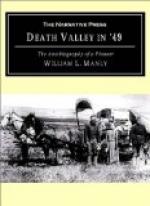We pulled the arrows out of the other oxen, and they seemed to sustain no great injury from the wounds. This little faint stream where we camped has since been named as Furnace Creek and is still known as such. It was named in 1862 by some prospectors who built what was called an air furnace on a small scale to reduce some ore found near by, which they supposed to contain silver, but I believe it turned out to be lead and too far from transportations to be available.
CHAPTER X.
Bennett and Arcane now concluded not to wait for me to go ahead and explore out a way for them to follow, as I had done for a long time, but to go ahead as it was evidently the best way to turn south and make our own road, and find the water and passes all for ourselves. So they hitched up and rolled down the canon, and out into the valley and then turned due south. We had not gone long on this course before we saw that we must cross the valley and get over to the west side. To do this we must cross through some water, and for fear the ground might be miry, I went to a sand hill near by and got a mesquite stick about three feet long with which to sound out our way. I rolled up my pants pulled off my moccasins and waded in, having the teams stand still till I could find out whether it was safe for them to follow or not by ascertaining the depth of the water and the character of the bottom.
The water was very clear and the bottom seemed uneven, there being some deep holes. Striking my stick on the bottom it seemed solid as a rock, and breaking off a small projecting point I found it to be solid rock salt. As the teams rolled along they scarcely roiled the water. It looked to me as if the whole valley which might be a hundred miles long might have been a solid bed of rock salt. Before we reached this water there were many solid blocks of salt lying around covered with a little dirt on the top.
The second night we found a good spring of fresh water coming out from the bottom of the snow peak almost over our heads. The small flow from it spread out over the sand and sank in a very short distance and there was some quite good grass growing around.
This was a temporary relief, but brought us face to face with stranger difficulties and a more hopeless outlook.
There was no possible way to cross this high steep range of mountains anywhere to the north and the Jayhawkers had abandoned their wagons and burned them, and we could no longer follow on the trail they made. It seemed that there was no other alternative but for us to keep along the edge of the mountain to the south and search for another pass. Some who had read Fremont’s travels said that the range immediately west of us must be the one he described, on the west side of which was a beautiful country, of rich soil and having plenty of cattle, and horses, and containing some settlers, but on the east all was barren, dry, rocky, sandy desert as far as could be seen. We knew this eastern side answered well the description and believed that this was really the range described, or at least it was close by.




